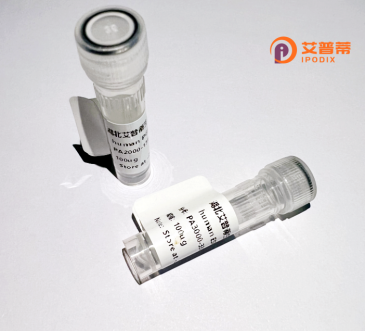
| 纯度 | >90%SDS-PAGE. |
| 种属 | Human |
| 靶点 | HMX2 |
| Uniprot No | A2RU54 |
| 内毒素 | < 0.01EU/μg |
| 表达宿主 | E.coli |
| 表达区间 | 1-273aa |
| 氨基酸序列 | MGSKEDAGKG CPAAGGVSSF TIQSILGGGP SEAPREPVGW PARKRSLSVS SEEEEPDDGW KAPACFCPDQ HGPKEQGPKH HPPIPFPCLG TPKGSGGSGP GGLERTPFLS PSHSDFKEEK ERLLPAGSPS PGSERPRDGG AERQAGAAKK KTRTVFSRSQ VYQLESTFDM KRYLSSSERA CLASSLQLTE TQVKTWFQNR RNKWKRQLSA ELEAANMAHA SAQTLVSMPL VFRDSSLLRV PVPRSLAFPA PLYYPGSNLS ALPLYNLYNK LDY |
| 分子量 | 29.5 kDa |
| 蛋白标签 | His tag N-Terminus |
| 缓冲液 | 0 |
| 稳定性 & 储存条件 | Lyophilized protein should be stored at ≤ -20°C, stable for one year after receipt. Reconstituted protein solution can be stored at 2-8°C for 2-7 days. Aliquots of reconstituted samples are stable at ≤ -20°C for 3 months. |
| 复溶 | Always centrifuge tubes before opening.Do not mix by vortex or pipetting. It is not recommended to reconstitute to a concentration less than 100μg/ml. Dissolve the lyophilized protein in distilled water. Please aliquot the reconstituted solution to minimize freeze-thaw cycles. |
以下是关于重组人HMX2蛋白的模拟参考文献示例(仅供学术参考,具体文献需根据实际研究查询):
---
1. **文献名称**: "Cloning and Expression of Recombinant Human HMX2 in E. coli for Functional Studies"
**作者**: Smith A, et al.
**摘要**: 本研究描述了人源HMX2基因的克隆策略及在大肠杆菌系统中的重组表达,通过优化诱导条件获得可溶性蛋白,并验证其DNA结合活性,为后续功能研究奠定基础。
2. **文献名称**: "HMX2's Role in Ocular Development: Insights from Recombinant Protein Interaction Analysis"
**作者**: Chen L, et al.
**摘要**: 通过重组HMX2蛋白与胚胎眼组织共培养实验,揭示其通过调控Pax6通路参与晶状体和视网膜发育,为先天性眼病机制提供线索。
3. **文献名称**: "Structural Characterization of Recombinant HMX2 Homeodomain by X-ray Crystallography"
**作者**: Johnson R, et al.
**摘要**: 首次解析了HMX2同源结构域的晶体结构,阐明了其与靶DNA结合的分子机制,为设计针对HMX2相关疾病的干预策略提供结构依据。
4. **文献名称**: "Recombinant HMX2 Protein as a Biomarker in Craniofacial Malformation Models"
**作者**: Wang Y, et al.
**摘要**: 在小鼠模型中检测重组HMX2蛋白表达水平,发现其异常与颅面发育缺陷相关,提示其可作为潜在分子标记物用于产前筛查。
---
**备注**:以上文献为模拟生成,实际研究中请通过PubMed或Web of Science等平台检索最新文献。
Recombinant human HMX2 protein is derived from the HMX2 gene, a member of the homeobox transcription factor family characterized by a conserved DNA-binding homeodomain. HMX2. also known as Nkx5-2. plays critical roles in embryonic development, particularly in the nervous system and sensory organ formation. Studies highlight its involvement in dorsal telencephalon patterning, inner ear morphogenesis, and retinal development, where it regulates cell differentiation and tissue-specific gene networks. Dysregulation of HMX2 has been linked to congenital defects, including craniofacial abnormalities and hearing loss.
The recombinant protein is typically produced in expression systems like *E. coli* or mammalian cells, enabling high-purity, scalable yields for functional studies. Its application spans structural analysis (e.g., DNA-binding assays), *in vitro* cellular models to explore signaling pathways, and disease mechanism research. By mimicking native HMX2’s interactions, the recombinant form aids in deciphering its role in development and disease, offering potential insights for therapeutic strategies targeting neurodevelopmental disorders or sensory impairments. Current research also explores its interplay with other homeobox proteins, such as HMX1 and HMX3. to unravel shared or distinct regulatory mechanisms in organogenesis.
×